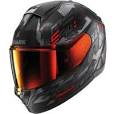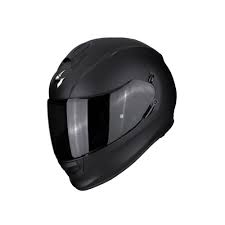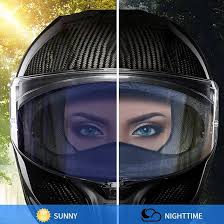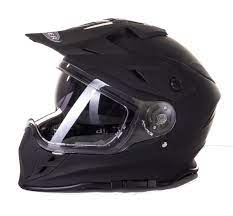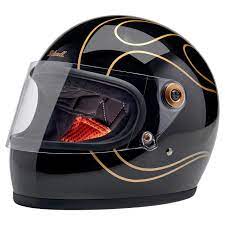
The Biltwell Gringo S: The Perfect Blend of Style and Safety
When it comes to motorcycle helmets, finding the perfect balance between style and safety can sometimes be a challenge. However, the Biltwell Gringo S effortlessly combines both elements, making it a top choice for riders who want to look good while prioritizing their protection on the road.
The Gringo S is a modern take on the classic full-face helmet design. Its sleek and timeless silhouette instantly captures attention, drawing inspiration from retro aesthetics that never go out of style. Whether you’re cruising through city streets or embarking on an epic adventure, this helmet will make you stand out from the crowd.
But it’s not just about looks; safety is paramount. The Gringo S is crafted with a strong and durable injection-molded ABS outer shell, providing excellent impact resistance. It meets stringent safety standards, ensuring that your head is well-protected in case of an accident. Additionally, its expanded polystyrene (EPS) foam liner absorbs shock effectively, further enhancing its protective capabilities.
Comfort is another essential factor that Biltwell has taken into consideration with the Gringo S. The interior features a hand-sewn diamond-stitched liner made from Lycra and open-cell foam for optimum comfort and breathability. This liner is also removable and washable, allowing you to keep your helmet fresh and clean after those long rides.
Another notable feature of the Gringo S is its versatility. It comes with a flip-up face shield that provides excellent visibility while protecting your eyes from wind, debris, and harmful UV rays. This shield can be easily opened or closed even when wearing gloves, making it convenient for riders who frequently transition between different riding conditions.
Biltwell understands that every rider has unique preferences when it comes to helmets. That’s why they offer various color options and customizable accessories for the Gringo S. Whether you prefer a classic solid color or a bold graphic design, you can personalize your helmet to match your individual style and make a statement on the road.
In conclusion, the Biltwell Gringo S is the ideal helmet for riders who refuse to compromise on style or safety. Its retro-inspired design, combined with its robust construction and attention to detail, make it a standout choice in the market. So why settle for anything less when you can have both style and protection in one exceptional helmet? Choose the Biltwell Gringo S and ride with confidence, knowing that you’re wearing a helmet that truly delivers on all fronts.
6 Essential Tips for Biltwell Gringo S Helmet Owners
- Size Matters
- Safety First
- Ventilation is Key
- Shield Maintenance
- Personalize Your Style
- Regular Cleaning
Size Matters
When it comes to motorcycle helmets, one crucial factor that should never be overlooked is the size. Choosing the right size helmet, such as the Biltwell Gringo S, is essential for both comfort and safety.
Wearing a helmet that is too small can lead to discomfort and even headaches during long rides. On the other hand, a helmet that is too large may not provide adequate protection in case of an accident. That’s why finding the perfect fit is vital.
The Biltwell Gringo S comes in a range of sizes to accommodate various head shapes and sizes. To determine your correct size, measure the circumference of your head using a flexible tape measure. Start above your eyebrows and wrap it around the widest part of your head. Refer to Biltwell’s sizing chart to find the corresponding helmet size for your measurement.
Remember, different brands may have slightly different sizing guidelines, so always consult each manufacturer’s specific chart when purchasing a new helmet.
It’s important to note that helmets should fit snugly but not be overly tight. When trying on the Gringo S or any other helmet, make sure it sits level on your head with no pressure points or gaps. The cheek pads should be snug against your cheeks without causing discomfort or restriction.
Don’t forget that our heads can change shape over time due to factors like weight loss or gain. Therefore, it’s recommended to periodically check if your helmet still fits properly and replace it if necessary.
Choosing the right size helmet like the Biltwell Gringo S ensures maximum comfort and optimal protection while you enjoy your motorcycle adventures. So remember, when it comes to motorcycle helmets – Size Matters!
Safety First
When it comes to riding motorcycles, safety should always be the top priority. One essential aspect of ensuring your safety on the road is choosing the right helmet, and the Biltwell Gringo S is a fantastic option that puts safety first.
The Gringo S is designed with your protection in mind. Its strong and durable construction, featuring an injection-molded ABS outer shell and an EPS foam liner, offers excellent impact resistance. This means that in case of an accident, your head will be well-protected from potential injuries.
In addition to its solid construction, the Gringo S also comes with a flip-up face shield. This shield not only shields your eyes from wind and debris but also provides crucial protection against harmful UV rays. Having a clear view of the road ahead while keeping your eyes safe is vital for maintaining focus and staying aware of your surroundings.
The Gringo S also prioritizes comfort, as it features a hand-sewn diamond-stitched liner made from breathable materials. This ensures that you can ride comfortably for extended periods without feeling restricted or uncomfortable.
Remember that wearing a helmet is not just about abiding by legal requirements; it’s about safeguarding yourself on every ride. The Biltwell Gringo S offers both style and safety, making it an excellent choice for riders who refuse to compromise on either aspect.
So, before you hit the road, make sure to prioritize safety by investing in a reliable helmet like the Biltwell Gringo S. With its robust construction, protective features, and comfortable design, this helmet will give you peace of mind as you embark on your two-wheeled adventures. Stay safe out there!
Ventilation is Key
When it comes to motorcycle helmets, ventilation is a key factor that should never be overlooked. The Biltwell Gringo S understands the importance of keeping riders cool and comfortable, even during long rides on hot summer days.
The Gringo S features strategically placed vents that allow for optimal airflow. These vents are designed to channel fresh air into the helmet while simultaneously expelling hot air and moisture. This intelligent ventilation system helps to regulate temperature and prevent excessive sweating, ensuring a more enjoyable riding experience.
Proper ventilation not only keeps you cool but also enhances safety. It helps to reduce fogging on the visor, ensuring clear visibility at all times. Additionally, improved airflow can prevent discomfort and fatigue, allowing you to stay focused on the road ahead.
Biltwell has taken great care in designing the Gringo S to maximize ventilation without compromising safety. The placement of the vents allows for efficient airflow while maintaining the helmet’s structural integrity.
So, whether you’re embarking on a thrilling ride through winding roads or simply commuting in heavy traffic, the Biltwell Gringo S ensures that you stay cool and comfortable throughout your journey.
Remember, when choosing a motorcycle helmet, don’t underestimate the importance of proper ventilation. With its well-designed venting system, the Biltwell Gringo S ensures that you can enjoy your ride with peace of mind and stay cool no matter where your adventures take you.
Shield Maintenance
Shield Maintenance: Keeping Your Biltwell Gringo S Looking Clear and Fresh
The Biltwell Gringo S helmet is not just a stylish accessory; it’s a vital piece of safety gear that protects your head while riding. One key component of this helmet is its face shield, which shields your eyes from wind, debris, and harmful UV rays. To ensure optimal visibility and longevity of your shield, proper maintenance is crucial.
Regular cleaning of your Gringo S shield is essential to keep it looking clear and fresh. Dust, bugs, and other particles can accumulate on the surface over time, hindering your vision on the road. To clean the shield effectively, start by rinsing it with lukewarm water to remove any loose debris.
Next, use a mild soap or helmet-specific cleaner to gently wash the shield. Avoid using harsh chemicals or abrasive materials that could potentially scratch the surface. Gently wipe away any stubborn dirt or grime with a soft cloth or sponge.
Once clean, rinse the shield thoroughly to remove any soap residue. Be sure to dry it completely before reattaching it to your helmet. This will prevent water spots or streaks from forming on the surface.
It’s important to note that some Gringo S shields come with an anti-fog coating for enhanced visibility in varying weather conditions. To preserve this coating and prevent scratches, avoid using paper towels or rough fabrics when cleaning the shield. Instead, opt for microfiber cloths or other soft materials specifically designed for delicate surfaces.
In addition to regular cleaning, proper storage of your Gringo S helmet can also contribute to maintaining the integrity of the shield. Store your helmet in a cool and dry place away from direct sunlight or extreme temperatures. This will help prevent warping or discoloration of both the helmet and its shield.
By following these simple maintenance tips, you can ensure that your Biltwell Gringo S face shield remains clear, scratch-free, and in optimal condition. Remember, a well-maintained shield not only enhances your riding experience but also ensures your safety on the road. So, take a few extra minutes to care for your Gringo S shield, and enjoy the clear view ahead on all your motorcycle adventures.
Personalize Your Style
One of the standout features of the Biltwell Gringo S helmet is its ability to be personalized to suit your unique style. With a range of customizable options and accessories, you can make this helmet truly your own.
The Gringo S offers a variety of color choices, allowing you to select a hue that aligns with your personality and preferences. Whether you prefer a classic solid color or something more vibrant and eye-catching, there is an option for everyone.
But it doesn’t stop there. Biltwell also offers a selection of graphic designs that can be applied to the helmet’s exterior. From subtle patterns to bold and intricate artwork, these graphics allow you to express yourself and make a statement on the road.
Additionally, the Gringo S is compatible with various accessories that further enhance its style and functionality. You can choose from different face shield options, including tinted or mirrored visors, adding an extra touch of flair while protecting your eyes from sunlight and debris.
Furthermore, Biltwell provides detachable grilles that can be easily installed on the front vents of the helmet. These grilles not only add a distinctive look but also offer protection against small particles entering through the vents.
Personalizing your Gringo S doesn’t just stop at its appearance; it extends to comfort as well. The interior liner is removable and washable, allowing you to keep your helmet fresh and clean after long rides. You can even swap out the liner for different thicknesses based on your preference for fit and comfort.
In summary, personalizing your Biltwell Gringo S allows you to create a helmet that reflects who you are as a rider. With various color options, graphic designs, accessories, and customizable liners, this helmet becomes an extension of your individual style while providing top-notch protection on every ride. So go ahead and make it yours – ride with confidence knowing that your Gringo S is uniquely tailored to you.
Regular Cleaning
Regular Cleaning: Keeping Your Biltwell Gringo S Helmet in Pristine Condition
Your Biltwell Gringo S helmet is not just a stylish accessory; it’s also an essential piece of safety equipment. To ensure that it continues to provide optimum protection and looks great, regular cleaning is key. By following a few simple steps, you can keep your helmet in pristine condition for years to come.
Firstly, start by removing any detachable parts such as the face shield or visor. These can be cleaned separately using mild soap and warm water. Gently scrub away any dirt or debris, making sure to rinse thoroughly and allow them to air dry.
Next, focus on the helmet itself. Use a soft cloth or sponge dampened with mild soap and warm water to wipe down the exterior surface. Pay extra attention to areas that may accumulate dirt or sweat, such as the chin strap and vents. Avoid using harsh chemicals or abrasive cleaners that could damage the helmet’s finish.
For stubborn stains or grime, a mixture of baking soda and water can work wonders. Apply this paste to the affected areas, gently scrubbing with a soft cloth before rinsing off thoroughly. Remember to be gentle during this process to avoid scratching the helmet’s surface.
Once you have cleaned the exterior, move on to the interior lining. Most Biltwell Gringo S helmets come with removable liners for easy cleaning. Follow the manufacturer’s instructions on how best to remove and wash these liners. Typically, they can be hand-washed using mild detergent and then air-dried before reinserting them into the helmet.
It’s important not to neglect the ventilation system of your helmet either. Use a small brush or cotton swab dipped in soapy water to clean out any debris that may have accumulated in the vents over time. This will help maintain proper airflow while riding.
Lastly, after cleaning all parts of your Biltwell Gringo S helmet, allow everything to air dry completely before reassembling. Avoid using direct heat sources or placing the helmet in direct sunlight, as this could cause damage or distortion.
Regular cleaning not only helps maintain the appearance of your helmet but also ensures that it remains hygienic and odor-free. By investing a little time and effort into cleaning your Biltwell Gringo S regularly, you can enjoy a fresh and safe riding experience every time you hit the road.
Remember, a clean helmet is a happy helmet – so make it a habit to clean your Biltwell Gringo S regularly and keep it looking and performing at its best.

